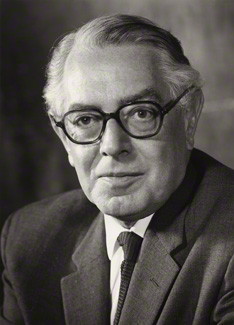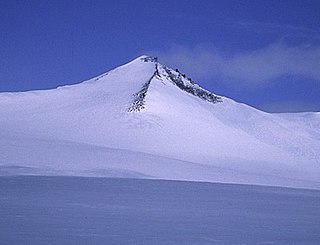
Ellesmere Island is Canada's northernmost and third largest island, and the tenth largest in the world. It comprises an area of 196,236 km2 (75,767 sq mi), slightly smaller than Great Britain, and the total length of the island is 830 km (520 mi).

Edward Arthur Alexander Shackleton, Baron Shackleton, was a British geographer, Royal Air Force officer and Labour Party politician.

Barbeau Peak is a mountain in Qikiqtaaluk, Nunavut, Canada. Located on Ellesmere Island within Quttinirpaaq National Park, it is the highest mountain in Nunavut and the Canadian Arctic. The mountain was named in 1969 after Marius Barbeau, a Canadian anthropologist whose research into First Nations and Inuit cultures gained him international acclaim.

The British Empire Range is a mountain range on Ellesmere Island in Nunavut, Canada. The range is one of the most northern ranges in the world and the Arctic Cordillera, surpassed only by the Challenger Mountains which lies immediately to the northwest and the United States Range slightly further east. The highest mountain in the range is Barbeau Peak.
Mount Eugene is the highest mountain of the United States Range on Ellesmere Island. Originally named "Mount Arthur Eugene" in 1883 by the States Army Signal Service during their Lady Franklin Bay expedition.
Mount Whisler is a mountain of the British Empire Range on Canada's Ellesmere Island. It is the second highest peak of the British Empire Range, of Ellesmere Island, and of the Arctic Cordillera. It is located about 12 km (7.5 mi) northeast of Barbeau Peak, the highest peak in the Cordillera. The Henrietta Nesmith Glacier completely surrounds Mount Whisler.
Gordon Noel Humphreys (1883–1966) was a British born surveyor, pilot, botanist, explorer and doctor. Originally trained as a surveyor, Humphreys worked in both Mexico and Uganda. During World War I he served as a pilot with the Royal Flying Corps, was shot down and spent his internment training himself in botany.
Turnabout Glacier is located on Ellesmere Island, Nunavut, Canada. It is drained by the Turnabout River.
Geoffrey Francis Hattersley-Smith D.Phil, FRSC, FRGS, FAINA was an English-born Canadian geologist and glaciologist, recognized as a pioneering researcher of Northern Canada.
Arrowhead Mountain is a mountain located on Ellesmere Island, Nunavut, Canada and is located east northeast of Mount Oxford. The mountain was named due to the four ridges that rise to a peak.
Mount Arthur is a mountain located on Ellesmere Island, Nunavut, Canada in the Quttinirpaaq National Park. First mapped by the Lady Franklin Bay Expedition, it was named for Chester A. Arthur the 21st President of the United States.
Mount Ayles is a mountain located on Ellesmere Island, Nunavut, Canada. It forms part of the border of the Quttinirpaaq National Park. Like the nearby Ayles Ice Shelf, the mountain was named by the Geological Survey of Canada in 1965 for Adam Ayles, a petty officer on-board HMS Alert, who was serving in the British Arctic Expedition under George Nares.
Mount Beaufort is a mountain located on Ellesmere Island, Nunavut, Canada and was named after Francis Beaufort. The mountain was first sighted by Elisha Kane in 1845 and named Mount Francis Beaufort.

The Arctic Cordillera is a terrestrial ecozone in northern Canada characterized by a vast, deeply dissected chain of mountain ranges extending along the northeastern flank of the Canadian Arctic Archipelago from Ellesmere Island to the northeasternmost part of the Labrador Peninsula in northern Labrador and northern Quebec, Canada. It spans most of the eastern coast of Nunavut with high glaciated peaks rising through ice fields and some of Canada's largest ice caps, including the Penny Ice Cap on Baffin Island. It is bounded to the east by Baffin Bay, Davis Strait and the Labrador Sea while its northern portion is bounded by the Arctic Ocean.

Mount Odin is a mountain in Qikiqtaaluk, Nunavut, Canada. It is located in Auyuittuq National Park along the Akshayuk Pass, 46 km (29 mi) north of Pangnirtung and south of Mount Asgard. Mount Odin is the highest mountain on Baffin Island.
Commonwealth Mountain is a mountain on Ellesmere Island, Nunavut, Canada. It lies in western Quttinirpaaq National Park, which is the most northerly extent of Canada, and is the second most northerly park on Earth after Northeast Greenland National Park.

The Conger Range, also called the Conger Mountains, is a mountain range in Quttinirpaaq National Park on Ellesmere Island, Nunavut, Canada, beginning about 16 km (10 mi) west of Mount Osborne. It is part of the Arctic Cordillera which is a vast dissected mountain system extending from Ellesmere Island to the northernmost tip of Labrador and northeastern Quebec. The Conger Range is a structural extension of the Garfield Range and continues into the highlands north of the head of Hare Fiord. The overall extent of the range is about 180 km (112 mi). Most of its peaks are ice-covered, although nearly all of the southern slopes are ice-free. Many of the valleys between the peaks are filled with glacial tongues spilling out to the south from the Grand Land Ice Cap. Its highest point is Mount Biederbick at 1,542 m (5,059 ft).
Sven Hedin Glacier is a glacier north of Princess Marie Bay on central Ellesmere Island, Nunavut, Canada. The glacier has the name of Sven Hedin. The Oxford University Ellesmere Land expedition visited the glacier in the year 1935. The Glacier appeared to be advancing in 1935.

Craig Harbour is an abandoned settlement in the Qikiqtaaluk Region, Nunavut, Canada. It is located on Ellesmere Island, on the north shore of Jones Sound, 55 km (34 mi) southeast of Grise Fiord.
David Haig-Thomas was a British ornithologist, wildlife photographer, explorer and rower who competed for Great Britain in the 1932 Summer Olympics. He was an army commando during the Second World War, and was killed in action during the Normandy Landings. Haig-Thomas Island in the Canadian Arctic is named after him.








